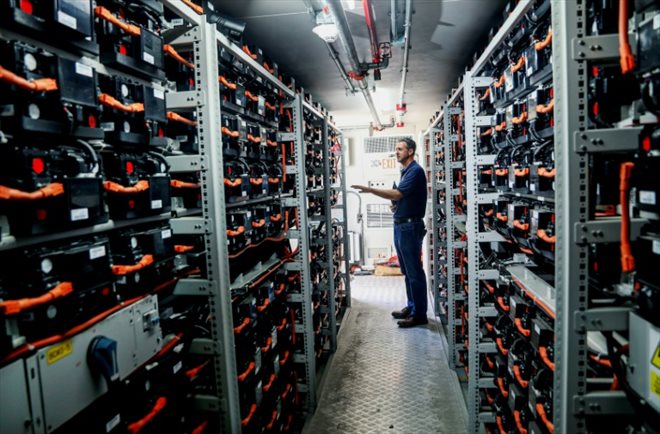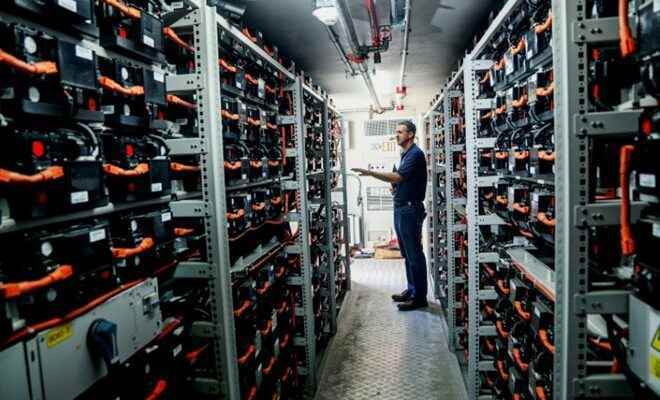Weikko Wirta, COO of AES Southland in front of a row of lithium batteries in Long Beach, California, on September 16, 2022 (AFP/Patrick T. FALLON)
The mercury hovered around 45°C in early September in California, but the electricity grid resisted, without major power outages unlike 2020. A performance due in part to the exponential installation of giant batteries, capable of storing solar energy .
In his Long Beach center, occupied by rows of thousands of batteries resembling a computer server farm, Weikko Wirta watched his 400 megawatt facility, one of the largest in the state, go into full swing during the heat wave.
“The batteries intervened and (…) played an essential role” during the last heat wave, explains to AFP the director of operations of the electricity supplier AES, at the controls of this new factory since 2021.
Thanks to them, the company was able to store the solar energy produced during the day and redistribute it in the evening to “fill in the gap between 4-5 p.m. and 10 p.m.”, when the drop in photovoltaic supply at sunset and demand air conditioning record risked causing a collapse of the electricity grid.
In August 2020, a brutal heat wave affecting the entire Western United States forced California, a pioneer in renewable energy, to cut power to 800,000 homes and businesses during certain time slots for two days. Unheard of for almost 20 years.
Faced with the return of extreme temperatures this year, such voluntary cuts were narrowly avoided in early September, thanks in particular to the race launched to meet California’s climate objectives.

Energy storage containers and solar panels at the University of San Diego in California on September 16, 2022 (AFP/SANDY HUFFAKER)
The state is aiming for 100% carbon-neutral energy production by 2045. Between 2020 and 2022, it increased its battery energy storage capacity tenfold, according to its energy commission.
On September 5, at the peak of the heat wave, the batteries were able to produce 3,300 megawatts in the evening, according to the California power grid regulator ISO.
“It’s more than the Diablo Canyon nuclear power plant, which is the largest power plant in the state and produces about 2,200 megawatts,” analyzes Mike Ferry, a researcher at the University of San Diego.
– Technology of the “future” –
“Barely perceptible” during the previous heat wave in 2020, this technology has established itself as “a key to allow the State to avoid power cuts”, by providing the energy margin missing from the network. It represents “the future of what our electricity network will look like”, he insists.
California is still very dependent on natural gas, and had to import electricity from other American states to withstand the last heat wave. The authorities have also multiplied alerts to reduce demand.
Several evenings in a row, residents were asked not to set the air conditioning below 25.5°C or to avoid recharging their electric vehicles during the most critical time slot.
Enough to relaunch the debate on the energy transition in the United States. Many Republican officials have mocked the Democratic state, attributing the weakness of the Californian grid to renewable energies and their intermittent production.

University of San Diego researcher Mike Ferry shows off a lithium battery pack, in La Jolla, California on September 16, 2022 (AFP/SANDY HUFFAKER)
“The forced march energy transition endangers the reliability of the electricity network”, tackled on Twitter, Kevin McCarthy, the leader of the conservative party in the House of Representatives.
“Instead of criticizing renewable energies, we should highlight the value of battery storage”, retorts Eric Fournier. A researcher at UCLA, the university underlines the interest of this technology capable of storing clean energy produced by solar and wind power.
As heat waves and extreme weather events are set to become more frequent with global warming, “tackling the source of the problem, by stopping greenhouse gas emissions, is the only rational solution”, he pleads.
For him, the other lesson of this heat wave remains the ease with which Californians have voluntarily reduced their use of electricity in the evening. This observation is all the more interesting since the State is currently developing programs to reward consumers who limit their consumption.
Rather than looking to equip the grid with enough batteries to handle transient peaks in demand, “paying people to not demand power for a small number of hours might be a better option in many cases.”
© 2022 AFP
Did you like this article ? Share it with your friends with the buttons below.




